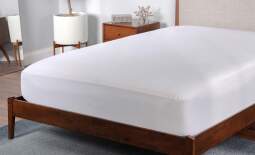The sheets are crisp and cool, the pillows fluffed and fresh, the lights are dim or off. But if you haven't covered your mattress with a protector, you're not 100 percent in the healthy sleep zone.
Mattress protectors and mattress encasements are a win-win for both people and mattresses. It protects your investment from spills and stains, allowing for maximum mileage from the mattress. Mattress protectors also keep your sleep space cleaner — protecting you and your family from breathing in allergens, dust mites and bacteria that can build up in your mattress over time.
Just as there are different types of mattresses, there are different types of protectors. Mattress protectors often cover the mattress like a fitted sheet, while mattress encasements have zippers and seals to encase the entire mattress or box spring. All of them are washable and will extend the life of your mattress while ensuring you have a clean, healthy sleep environment.
Types of Waterproof Mattress Protector Materials
Mattress protectors often have a waterproof backing, typically made from one of the following two materials:
- Polyurethane: This is a super-thin, flexible membrane that is used to waterproof fabrics while remaining undetectable and silent during sleep. This type of mattress protector material is highly breathable, prevents liquids from penetrating the cover but still allows air to pass through — keeping you at a comfortable sleeping temperature throughout the night.
- Plastic & Vinyl: This material type will help provide a waterproof barrier for the mattress, but often lacks breathability and may be noisier than the higher-quality polyurethane counterparts.
Spills and Stains
Spills and stains are a fact of life, but they don't have to wreak havoc on your wallet. Covering mattresses with a protector will shield the material inside the mattress. Exposure to moisture, particularly if prolonged — and simply sweating at night falls within this category — accelerates mattress breakdown. That's why the appearance of stains often voids mattress warranties.
Allergens and Dust Mites
Mattress protectors provide a barrier between you and dust mites. An estimated 50 million Americans suffer from allergies, and among the greatest causes are dust mites and their allergens. The bedroom also contains the greatest number of pet allergens, which makes mattress protection a key component of healthy sleep hygiene.
In addition to providing a barrier for dust mites and allergens, the moisture barrier that a mattress protector provides helps prevent mold and mildew from growing inside the mattress — giving you a healthier sleep experience.
Protect the Protector
With proper care, mattress protectors should be replaced ever few years. Look for one that has been test-washed up to 200 times, and if you follow the care instructions carefully, a protector can be washed as often as you wash your sheets.
Mattresses are an important investment — you’ll spend one third of the next eight years sleeping on it. It's essential to protect this investment with a protector that will help you sleep better for the life of your mattress.









